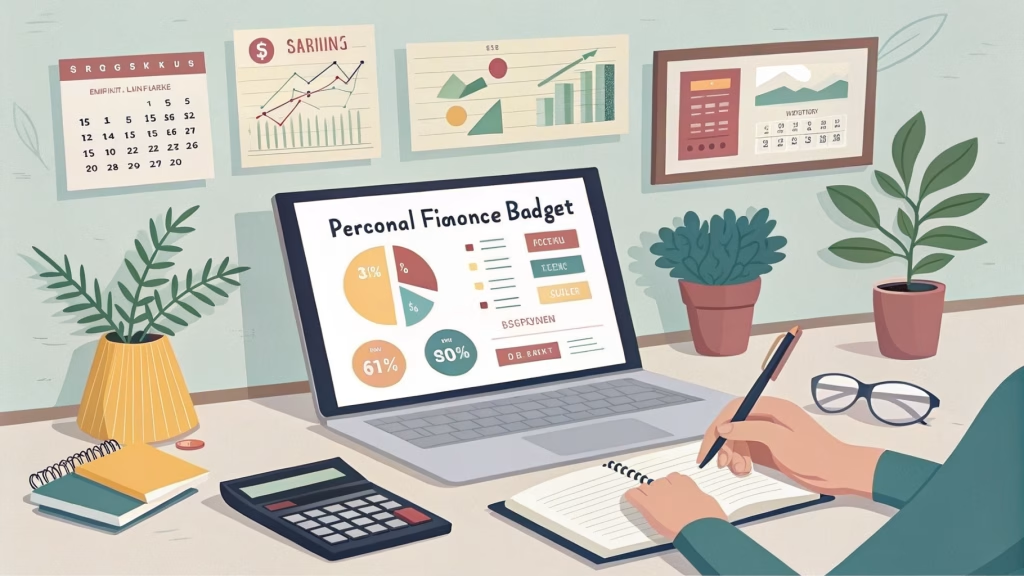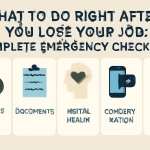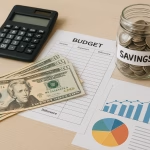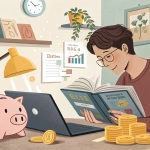Making your first budget might feel scary. But making a personal money budget for new people is easy. Almost 60% of people in America worry about money. The good news is a good budget can change everything. It gives you power over your money. It helps you sleep better at night.
You don’t need to be a math pro or money expert to win. With the right steps, you can make a budget that works for your life. This guide will show you each step. You’ll learn simple ways that real people use every day.
Find Your Real Income
The first step is knowing your real income. Many people use their full salary. This is wrong. They use money they don’t really have. This leads to spending too much.
Look at your pay stub. Find your net income. This is money that goes in your bank after taxes. Add your main paycheck and any side job money you get for sure. If you work as a freelancer, use the lowest amount you made last year. This keeps you safe from money problems.
Don’t forget to add back any 401k money or insurance costs from your check. These are still part of your money for budgets. If you get paid weekly, times it by 4.3 for your monthly income. If you get paid every two weeks, times it by 2.17 for your monthly total.
Track Your Monthly Bills
Before you can make a budget, you need to know where your money goes. Most people are shocked when they see their real spending. Tracking bills is key for making a personal money budget for new people. It helps you find areas where you can cut back. It helps you see your spending habits. It helps you make smart money choices.
Get your bank papers and credit card bills from last month. Write down every cost, no matter how small. That $5 coffee adds up fast. Sort your costs into two main groups: fixed and changing.
Fixed costs stay the same each month. These are rent, car payments, insurance, and minimum debt payments. Changing costs move up and down each month. Think food, gas, fun, and eating out. Don’t forget costs that happen once a year like insurance or holiday gifts. These catch many new people off guard.
Track your spending for at least one month before making your budget. This gives you real numbers to work with. Write everything in a notebook, computer sheet, or budget app. The goal is to see your spending habits, not judge them.
Pick Your Budget Way
There’s no single way to make a personal money budget for new people. Different ways work for different people. Here are four popular choices that new people love.
The 50/30/20 budget is a simple way that new people find easy. It’s a flexible way where you put 50% of your income to needs, 30% to wants, and 20% to savings. If your monthly income is $3,000, you’d spend $1,500 on needs, $900 on wants, and $600 on savings.
Envelope budgeting is a strong tool for those who spend too much. It shows your spending in a clear way. You put cash in different envelopes for spending, and when the envelope is empty, you’re done spending in that area.
Zero-based budgeting means every dollar has a job. Your income minus all costs equals zero. This doesn’t mean you’re broke. It means you’ve planned for every dollar. If you have $100 left after paying all your bills, you could put $50 to savings, $30 to eating out, and $20 to fun. This way gives you full control but takes more time.
Pay-yourself-first budgeting puts savings first. You save money first, then spend what’s left. This way is great if you find it hard to save money. Set up auto transfers to make it even easier.
Set Real Money Goals
Setting goals gives your budget a purpose. Without clear goals, giving up is easy when budgeting gets tough. Your goals should push you to stick with your budget.
Setting real money goals is a key part of your budget. These goals should be doable within 3-6 months. Like saving $1,000 for problems or paying off a credit card. Write down your goals and put them where you’ll see them daily. This keeps you going when you want to spend too much.
Make your goals clear and easy to measure. Instead of “save money,” try “save $500 for a trip by December.” This gives you a clear target to work toward. Break big goals into smaller monthly targets. Saving $1,200 feels too hard, but $100 per month is doable.
Don’t forget long-term goals like retirement or buying a house. These might seem far away, but starting early makes getting them much easier. Even $50 per month toward retirement makes a huge difference over time.
Build Your Emergency Fund
An emergency fund is your money safety net. Over half of people in America can’t cover a $1,000 emergency. Don’t let this be you. Building an emergency fund is a key part of making a personal money budget for new people.
Start small if you need to. Even $20 per month adds up over time. Your first goal should be $500-$1,000. This covers most small problems like car fixes or doctor bills. Once you reach this goal, work toward 3-6 months of costs.
Keep your emergency fund in a separate savings account. This stops you from spending it on non-problems. Look for a high-yield savings account to earn more interest. Some banks offer auto transfers to make saving easier.
Remember, your emergency fund is only for real problems. A vacation or a new TV doesn’t count. If you use your emergency fund, make building it back your top goal.
Avoid Common Budget Mistakes
Even with the best plans, new people make expected mistakes when learning how to make a personal money budget. Knowing these mistakes helps you avoid them.
The biggest mistake is making a budget that’s not real. If you usually spend $600 on food, don’t budget $300. This sets you up to fail. Start with real numbers based on your actual spending. You can always change later.
Another common mistake is forgetting costs that happen sometimes. Birthday gifts, car papers, and yearly sign-ups add up. Budget for these by setting aside money each month. If you spend $600 per year on gifts, budget $50 per month.
Remember to budget for fun. A budget that’s too strict will not last. Include money for fun and eating out. This will make your budget work long-term.
Many new people also give up after one bad month. Budgeting is a skill that takes practice. If you spend too much in one area, adjust and keep going. The key is progress, not being perfect.
Key Budget Tools and Help
The right tools make budgeting easier. You don’t need costly software to win. Many free choices work great for new people.
Computer sheets are a popular choice for making a personal money budget for new people. Google Sheets has free budget templates. Excel also has built-in budget templates. These give you full control over your budget.
Budget apps can do much of the work for you. Mint connects to your bank account and tracks spending by itself. YNAB uses zero-based budget rules. PocketGuard shows how much you have left to spend.
Don’t overlook simple tools like a pen and paper. Many winning budgeters still use written budgets. The best budget tool is the one you’ll use all the time.
Check and Change Your Budget Monthly
Your budget isn’t a set-it-and-forget-it tool. Regular checks are key for making a personal money budget for new people. Plan time each month to check your budget.
Compare your actual spending to your budget amounts. Look for areas where you spent too much or too little. Don’t panic if you went over budget. Use it as a learning chance. Change your budget based on what you learned.
Life changes, and your budget should change, too. Got a raise? Update your income. Have a new baby? Change your costs. Regular checks keep your budget real and useful.
Ready to Take Control of Your Money
Learning how to make a personal money budget for new people doesn’t have to be hard. Start by finding your real income and tracking your costs. Pick a budget way that fits you. Set real goals and build your emergency fund slowly.
Remember, budgeting is a skill that gets better with practice. Don’t expect to be perfect right away. The most important step is to start. Your future self will thank you for taking control of your money today.





